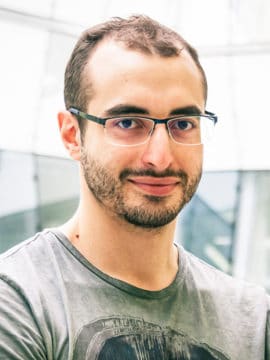Videoconfence: https://u-bordeaux-fr.zoom.us/j/84148960532
Defense in french
Title
Microscopie par localisation de molécules individuelles en profondeur utilisant la technologie sospim et l’optique adaptative.
(Single Molecule Localization Microscopy in depth using soSPIM and adaptive optics)
Abstract
Advances in scientific knowledge are often correlated with the development of new instrumental techniques. Biology is no exception to the rule. The recent development of super–resolution fluorescence microscopy techniques, awarded by the Nobel Prize in Chemistry in 2014, has revolutionized the way biological samples are observed by allowing to overcome the resolution limit dictated by light diffraction (~200nm) and previously considered insurmountable. Among these techniques, Single Molecule Localization Microscopy (SMLM) allows to image the organization of proteins inside cells with the best spatial resolutions (~10nm) and gives the possibility to follow their dynamics over time. These new capabilities open the way to a better understanding of the cellular machinery, essential to better fight against its dysfunctions at the origin of many diseases.
However, the detection of single molecules for super–resolution imaging by SMLM is particularly challenging and requires both high optical sectioning and high signal collection efficiency. As a result, it is performed using specialized microscopy systems with extremely shallow sample penetration depths. The single–lens light sheet microscopy system developed in our team, named soSPIM, allows to overcome this limitation. By combining a deep optical sectioning with the use of a high numerical aperture objective, it allows the detection of individual molecules several tens of microns above a coverslip.
Imaging whole volumes, such as whole cells, at these depths, however, rises new challenges. In excitation, light diffraction imposes a significant trade–off between the fineness of sectioning that can be achieved and the field of view. To overcome this, I sought to implement non–diffractive light sheet illumination to the soSPIM system. In detection, the performance of SMLM imaging depends directly on the optical quality of the system. Defects, called optical aberrations, appear systematically with the imaging depth. To correct these aberrations, I have implemented an adaptive optics system in the soSPIM microscope to allow precise 3D localization of individual molecules at depth. Finally, beyond the optical challenges, the acquisition and reconstruction procedures themselves present many difficulties. I have therefore developed several tools to considerspatial drifts and acquisition automation, and to reconstruct imaged volumes (~20x20x20 μm3) with nanometric resolutions. These developments have allowed the imaging of whole cells at 30μm depth with resolutions of 5nm radially (x,y) and 25nm axially (z). This work provides a solid proof of concept of the soSPIM system’s in depthSMLM imaging capability andpaves the way for the observation of new biological structures at previously inaccessible nanometer resolutions.
Keywords: Adaptive Optics, Light–Sheet Microscopy, Single Molecules Localization Microscopy, Super–Resolution, Drift Correction, Non–DiffractiveBeam
Jury
Rémi Galland : Directeur de thèse
Valentin Nägerl : Président
Sandrine Leveque-Fort : Rapportrice
Alexandra Fragola : Rapportrice


